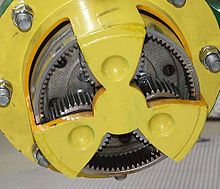Countershaft

Countershaft axles are drive axles for vehicles in which the hub underdrive be translated are gear transmission installed. This design enables thinner drive shafts , since the hub gears are involved in increasing the drive torque required by the wheels . However, the transmissions increase the unsprung mass , which is why they are not used in cars and other vehicles that transport people. Epicyclic gears are usually installed with the advantage that the drive shafts are coaxial with the wheel hub.
Portal axles contain single-stage spur gears built into the wheel carriers . The speed ratio to slow is a side advantage here. The primary purpose is the axially parallel offset of the drive shafts relative to the vehicle wheel axles. All-terrain vehicles are given greater ground clearance between the driven wheels. The drive shafts are higher. In the case of low-floor buses, reversed portal axles are used in order to be able to lower the floor over the axles.
A reduction gear is also understood to mean an expansion of a gear unit by an additional gear unit , which is usually connected downstream when the gear ratio is reduced. It is characteristic, however, that the gearboxes are switchable, whereby the “presented” gearbox part can be switched on or off and bypassed. The number of possible gear steps is the product of the number of gears in the two transmissions. A four-speed transmission and a two-speed reduction gear together result in eight gears, for example four long gears for the road and four short ones for the terrain or the field.
